Potřebujeme váš souhlas k využití jednotlivých dat, aby se vám mimo jiné mohly ukazovat informace týkající se vašich zájmů. Souhlas udělíte kliknutím na tlačítko „OK“.
ASTM C1211-13
Standard Test Method for Flexural Strength of Advanced Ceramics at Elevated Temperatures
Automaticky přeložený název:
Standardní zkušební metoda pro pevnost v ohybu pokročilých keramiky při zvýšených teplotách
NORMA vydána dne 1.8.2013
Informace o normě:
Označení normy: ASTM C1211-13
Poznámka: NEPLATNÁ
Datum vydání normy: 1.8.2013
Kód zboží: NS-10059
Počet stran: 17
Přibližná hmotnost: 51 g (0.11 liber)
Země: Americká technická norma
Kategorie: Technické normy ASTM
Kategorie - podobné normy:
Ostatní normy týkající se keramiky
Keramika pro pokrokové technologie
Anotace textu normy ASTM C1211-13 :
Keywords:
elevated temperature, flexural strength, four-point flexure, three-point flexure, ICS Number Code 81.060.99 (Other standards related to ceramics), 81.060.30 (Advanced ceramics)
Doplňující informace
| Significance and Use | ||||||||||||||||||
|
4.1 This test method may be used for material development, quality control, characterization, and design data generation purposes. This test method is intended to be used with ceramics whose flexural strength is ∼ 50 MPa (∼ 7 ksi) or greater. 4.2 The flexure stress is computed based on simple beam theory, with assumptions that the material is isotropic and homogeneous, the moduli of elasticity in tension and compression are identical, and the material is linearly elastic. The average grain size should be no greater than 1/50 of the beam thickness. The homogeneity and isotropy assumptions in the test method rule out the use of it for continuous fiber-reinforced composites for which Test Method C1341 is more appropriate. 4.3 The flexural strength of a group of test specimens is influenced by several parameters associated with the test procedure. Such factors include the testing rate, test environment, specimen size, specimen preparation, and test fixtures. Specimen and fixture sizes were chosen to provide a balance between the practical configurations and resulting errors as discussed in Test Method C1161, and Refs (1-3).4 Specific fixture and specimen configurations were designated in order to permit the ready comparison of data without the need for Weibull size scaling. 4.4 The flexural strength of a ceramic material is dependent on both its inherent resistance to fracture and the size and severity of flaws. Variations in these cause a natural scatter in test results for a sample of test specimens. Fractographic analysis of fracture surfaces, although beyond the scope of this test method, is highly recommended for all purposes, especially if the data will be used for design as discussed in Ref (4.5 This method determines the flexural strength at elevated temperature and ambient environmental conditions at a nominal, moderately fast testing rate. The flexural strength under these conditions may or may not necessarily be the inert flexural strength. Flexure strength at elevated temperature may be strongly dependent on testing rate, a consequence of creep, stress corrosion, or slow crack growth. If the purpose of the test is to measure the inert flexural strength, then extra precautions are required and faster testing rates may be necessary. 4.6 The three-point test
configuration exposes only a very small portion of the specimen to
the maximum stress. Therefore, three-point flexural strengths are
likely to be much greater than four-point flexural strengths.
Three-point flexure has some advantages. It uses simpler test
fixtures, it is easier to adapt to high temperature, and it is
sometimes helpful in Weibull statistical studies. However,
four-point flexure is preferred and recommended for most
characterization purposes.
4.7 The three-point test configuration exposes only a very small portion of the specimen to the maximum stress. Therefore, three-point flexural strengths are likely to be much greater than four-point flexural strengths. Three-point flexure has some advantages. It uses simpler test fixtures, it is easier to adapt to high temperature, and it is sometimes helpful in Weibull statistical studies. However, four-point flexure is preferred and recommended for most characterization purposes. |
||||||||||||||||||
| 1. Scope | ||||||||||||||||||
|
1.1 This test method covers determination of the flexural strength of advanced ceramics at elevated temperatures.1.2 The values stated in SI units are to be regarded as the standard. The values given in parentheses are for information only. 1.3 This standard does not purport to address all of the safety concerns, if any, associated with its use. It is the responsibility of the user of this standard to establish appropriate safety and health practices and determine the applicability of regulatory limitations prior to use. |
||||||||||||||||||
| 2. Referenced Documents | ||||||||||||||||||
|
Podobné normy:
Historická
1.12.2010
Historická
1.6.2010
Historická
1.12.2010
Historická
15.7.2010
Historická
1.1.2010
Historická
1.8.2013
Doporučujeme:
Aktualizace technických norem
Chcete mít jistotu, že používáte pouze platné technické normy?
Nabízíme Vám řešení, které Vám zajistí měsíční přehled o aktuálnosti norem, které používáte.
Chcete vědět více informací? Podívejte se na tuto stránku.


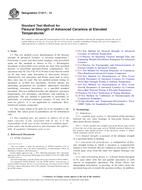
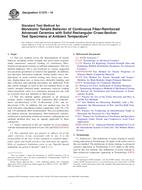 ASTM C1275-10
ASTM C1275-10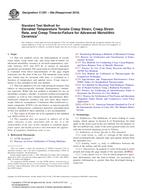 ASTM C1291-00a(2010)..
ASTM C1291-00a(2010).. ASTM C1292-10
ASTM C1292-10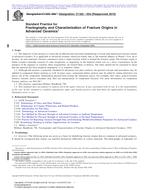 ASTM C1322-05b(2010)..
ASTM C1322-05b(2010)..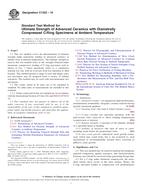 ASTM C1323-10
ASTM C1323-10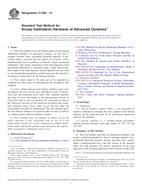 ASTM C1326-13
ASTM C1326-13
 Cookies
Cookies
